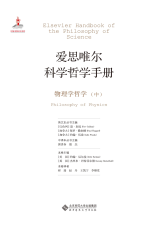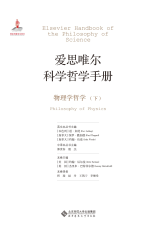物理学哲学
对物理学的研究成果作哲学的概括,研究物理学领域的哲学问题的一门科学。哲学与物理学相互联系和渗透的交叉学科。它为物理学研究提供一般的方法论。古典的物理学哲学的奠基人是英国科学家牛顿。现代在这方面研究有影响的人物有英国的孔德、奥地利的马赫、德国的海森堡、爱因斯坦等。研究的主要内容有:1.物理学本身的发展变化以及它所提供的时空观、运动观、物质观和研究方法的发展变化的内在规律;2.物理学中的各种矛盾(如机械运动中的静止与运动、作用与反作用,电磁运动中电与磁,原子核与电子的吸引与排斥等关系)的运动特点及发展;3.物理学规律(如能量守恒定律,热力学第一定律、第二定律、第三定律,质能关系定律等)的哲学意义。中国学者曾运用物质无限可分和层次性的原理提出的“层次”理论在物理学哲学领域产生过积极影响。当前物理学的许多领域又取得了巨大的发展,如半导体物理学、核物理学、分子物理学、激光物理学等,对物理学哲学提出了一系列新课题。

并列正书名: Elsevier Handbook of the Philosophy of Science Philosophy of Physics
主要责任者: [美国]约翰·厄尔曼(John;程瑞,赵丹,王凯宁,李继堂
责任方式: Earman),[美国]杰里米·巴特菲尔德(Jeremy Butterfield) 本卷主编;本卷译者
出版者: 北京师范大学出版社
出版地: 北京
字数: 1640 千字
页码: 472-1240
中图分类号: O4
分辑名:中
语种:中
定价:350.00
出版时间:2015-12
丛书多卷书否:是
丛书责任者:郭贵春,殷杰 中译本丛书主编
书目简介:本册工具书是爱思唯尔科学哲学手册之一,共收录187条词条。
被引频次:3

并列正书名: Elsevier Handbook of the Philosophy of Science Philosophy of Physics
主要责任者: [美国]约翰·厄尔曼(John;程瑞,赵丹,王凯宁,李继堂
责任方式: Earman),[美国]杰里米·巴特菲尔德(Jeremy Butterfield) 本卷主编;本卷译者
出版者: 北京师范大学出版社
出版地: 北京
字数: 1640 千字
页码: 1242-1697
中图分类号: O4
分辑名:下
语种:中
定价:350.00
出版时间:2015-12
丛书多卷书否:是
丛书名:爱思唯尔科学哲学手册
丛书责任者:郭贵春,殷杰 中译本丛书主编
书目简介:本册工具书是爱思唯尔科学哲学手册之一,共收录129条词条。
被引频次:3